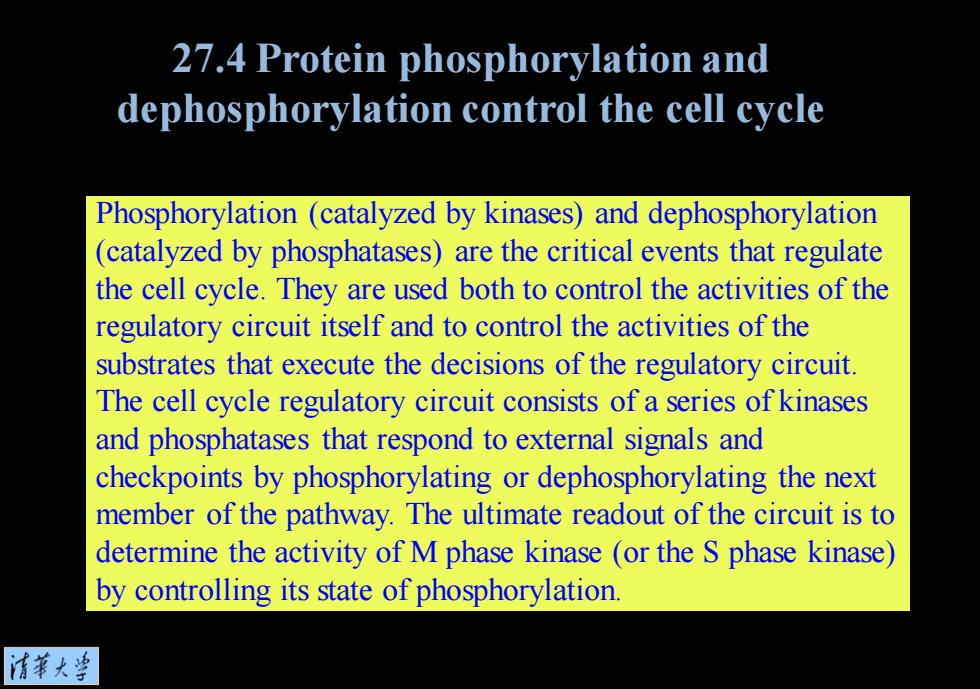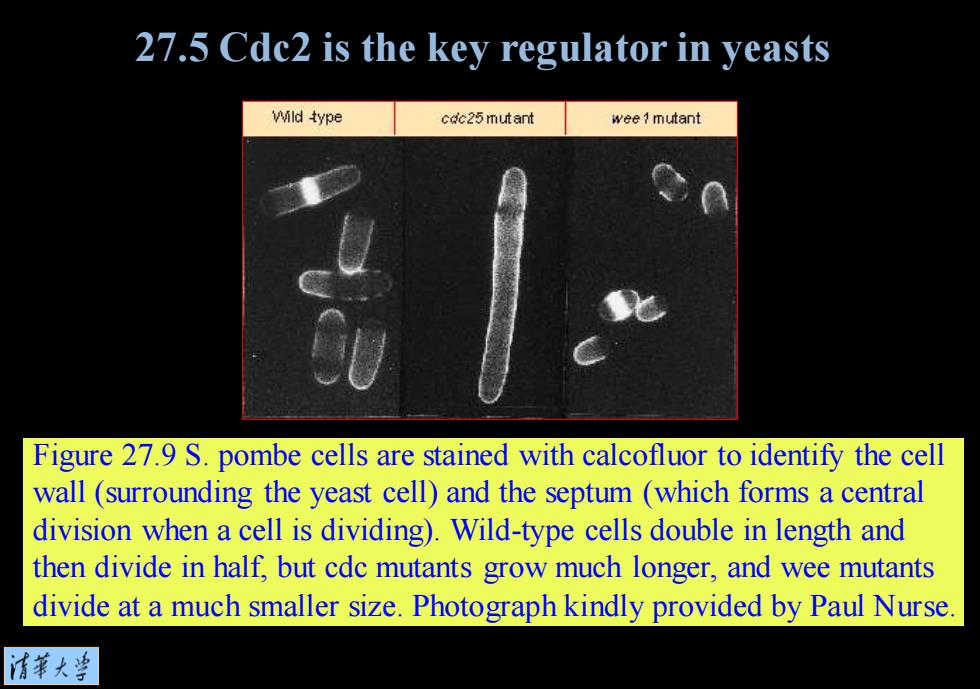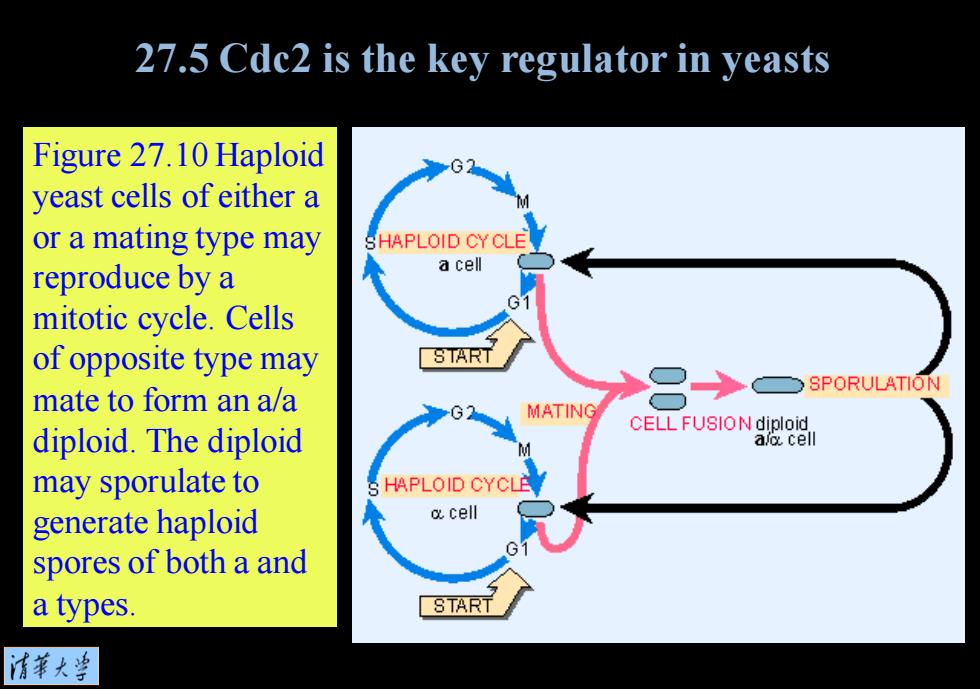
27.4 Protein phosphorylation and dephosphorylation control the cell cycle Phosphorylation (catalyzed by kinases)and dephosphorylation (catalyzed by phosphatases)are the critical events that regulate the cell cycle.They are used both to control the activities of the regulatory circuit itself and to control the activities of the substrates that execute the decisions of the regulatory circuit. The cell cycle regulatory circuit consists of a series of kinases and phosphatases that respond to external signals and checkpoints by phosphorylating or dephosphorylating the next member of the pathway.The ultimate readout of the circuit is to determine the activity of M phase kinase (or the S phase kinase) by controlling its state of phosphorylation. 情菜大兰
Phosphorylation (catalyzed by kinases) and dephosphorylation (catalyzed by phosphatases) are the critical events that regulate the cell cycle. They are used both to control the activities of the regulatory circuit itself and to control the activities of the substrates that execute the decisions of the regulatory circuit. The cell cycle regulatory circuit consists of a series of kinases and phosphatases that respond to external signals and checkpoints by phosphorylating or dephosphorylating the next member of the pathway. The ultimate readout of the circuit is to determine the activity of M phase kinase (or the S phase kinase) by controlling its state of phosphorylation. 27.4 Protein phosphorylation and dephosphorylation control the cell cycle

27.5 Cdc2 is the key regulator in yeasts Cyclins are proteins that accumulate continuously throughout the cell cycle and are then destroyed by proteolysis during mitosis.A cyclin is one of the two subunits of the M-phase kinase. G1 is the period of the eukaryotic cell cycle between the last mitosis and the start of DNA replication. 清菜大兰
Cyclins are proteins that accumulate continuously throughout the cell cycle and are then destroyed by proteolysis during mitosis. A cyclin is one of the two subunits of the M-phase kinase. G1 is the period of the eukaryotic cell cycle between the last mitosis and the start of DNA replication. 27.5 Cdc2 is the key regulator in yeasts

27.5 Cde2 is the key regulator in yeasts S.pombe 城 G1 G2 G1 >G2> S.cerevisiae ■■■■■■■■ Figure 27.8 S.pombe lengthens and then divides during a conventional cell cycle,while S.cerevisiaebuds during a cycle in which G2 is absent or very brief,and M occupies the greatest part. 情華大当
Figure 27.8 S. pombe lengthens and then divides during a conventional cell cycle, while S. cerevisiaebuds during a cycle in which G2 is absent or very brief, and M occupies the greatest part. 27.5 Cdc2 is the key regulator in yeasts

27.5 Cdc2 is the key regulator in yeasts wild type cdc25 mutant wee1mutant Figure 27.9 S.pombe cells are stained with calcofluor to identify the cell wall(surrounding the yeast cell)and the septum (which forms a central division when a cell is dividing).Wild-type cells double in length and then divide in half,but cdc mutants grow much longer,and wee mutants divide at a much smaller size.Photograph kindly provided by Paul Nurse 清第大当
Figure 27.9 S. pombe cells are stained with calcofluor to identify the cell wall (surrounding the yeast cell) and the septum (which forms a central division when a cell is dividing). Wild-type cells double in length and then divide in half, but cdc mutants grow much longer, and wee mutants divide at a much smaller size. Photograph kindly provided by Paul Nurse. 27.5 Cdc2 is the key regulator in yeasts

27.5 Cdc2 is the key regulator in yeasts Figure 27.10 Haploid yeast cells of either a or a mating type may SHAPLOID CY CLE a cell reproduce by a mitotic cycle.Cells of opposite type may START mate to form an a/a MATING CELL FUSION diploid diploid.The diploid alo cel may sporulate to S HAPLOID CYCLE generate haploid o cell spores of both a and a types. START 清菜大当
Figure 27.10 Haploid yeast cells of either a or a mating type may reproduce by a mitotic cycle. Cells of opposite type may mate to form an a/a diploid. The diploid may sporulate to generate haploid spores of both a and a types. 27.5 Cdc2 is the key regulator in yeasts